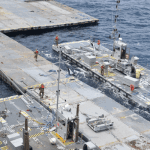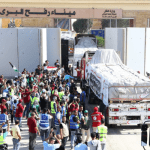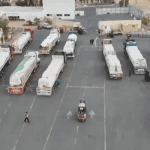U.S military has announced that the first cargo of humanitarian aid arrived in Gaza via a temporary floating pier.
According to the U.S Central Command, relief vehicles began arriving on shore at 09:00 local time (07:00 BST) on Friday.
Prime Minister Rishi Sunak described the distribution of 8,400 plastic shelters as “the culmination of a herculean joint international effort.”
In the next weeks, some 500 tonnes of British supplies, including tents, hygiene kits, and forklift trucks, are due to arrive via the dock, which was built by US forces.
The UK has played a supporting role in the construction of the pier, which was anchored to the shore on Thursday, providing accommodation for US personnel on the Royal Fleet Auxiliary vessel Cardigan Bay.
Foreign Secretary Lord Cameron said the maritime route was “just one part of the bigger picture,” and land routes were “the most effective means of getting aid into Gaza at the scale needed.”
He added: “Gazans are at risk of famine and in desperate need of supplies – Israel must ensure land routes are open and that aid gets safely to where it is needed.”
The pier is expected to provide access for 90 truckloads of aid at first, increasing to 150 truckloads once it is fully operational.
Both Lord Cameron and the prime minister reaffirmed demands that Israel fulfill its promise to open as many channels as feasible for humanitarian aid to enter Gaza and to permit at least 500 relief trucks per day to enter the area through land crossings.
In order to construct and run the pier, British and American employees have been collaborating at RFA Cardigan Bay.
Hundreds of tonnes of aid arrived in Cyprus on Wednesday, where it was screened before being loaded on to commercial ships for delivery to the pier.
Smaller US military vessels – capable of carrying between five and 15 lorries of aid – then transported it to the floating pier, which is several hundred metres long and fixed to the beach in Gaza.
The lorries travelled along the pier before dropping off the aid at a marshalling yard on the beach.
Authorities said that the UN, primarily the World Food Programme, would be responsible for the onward distribution of aid.
Aid deliveries to the territory have slowed down since Israeli forces took control of the Gaza side of the Rafah crossing last week.
U.S military has announced that the first cargo of humanitarian aid arrived in Gaza via a temporary floating pier.
According to the U.S Central Command, relief vehicles began arriving on shore at 09:00 local time (07:00 BST) on Friday.
Prime Minister Rishi Sunak described the distribution of 8,400 plastic shelters as “the culmination of a herculean joint international effort.”
In the next weeks, some 500 tonnes of British supplies, including tents, hygiene kits, and forklift trucks, are due to arrive via the dock, which was built by US forces.
The UK has played a supporting role in the construction of the pier, which was anchored to the shore on Thursday, providing accommodation for US personnel on the Royal Fleet Auxiliary vessel Cardigan Bay.
Foreign Secretary Lord Cameron said the maritime route was “just one part of the bigger picture,” and land routes were “the most effective means of getting aid into Gaza at the scale needed.”
He added: “Gazans are at risk of famine and in desperate need of supplies – Israel must ensure land routes are open and that aid gets safely to where it is needed.”
The pier is expected to provide access for 90 truckloads of aid at first, increasing to 150 truckloads once it is fully operational.
Both Lord Cameron and the prime minister reaffirmed demands that Israel fulfill its promise to open as many channels as feasible for humanitarian aid to enter Gaza and to permit at least 500 relief trucks per day to enter the area through land crossings.
In order to construct and run the pier, British and American employees have been collaborating at RFA Cardigan Bay.
Hundreds of tonnes of aid arrived in Cyprus on Wednesday, where it was screened before being loaded on to commercial ships for delivery to the pier.
Smaller US military vessels – capable of carrying between five and 15 lorries of aid – then transported it to the floating pier, which is several hundred metres long and fixed to the beach in Gaza.
The lorries travelled along the pier before dropping off the aid at a marshalling yard on the beach.
Authorities said that the UN, primarily the World Food Programme, would be responsible for the onward distribution of aid.
Aid deliveries to the territory have slowed down since Israeli forces took control of the Gaza side of the Rafah crossing last week.
U.S military has announced that the first cargo of humanitarian aid arrived in Gaza via a temporary floating pier.
According to the U.S Central Command, relief vehicles began arriving on shore at 09:00 local time (07:00 BST) on Friday.
Prime Minister Rishi Sunak described the distribution of 8,400 plastic shelters as “the culmination of a herculean joint international effort.”
In the next weeks, some 500 tonnes of British supplies, including tents, hygiene kits, and forklift trucks, are due to arrive via the dock, which was built by US forces.
The UK has played a supporting role in the construction of the pier, which was anchored to the shore on Thursday, providing accommodation for US personnel on the Royal Fleet Auxiliary vessel Cardigan Bay.
Foreign Secretary Lord Cameron said the maritime route was “just one part of the bigger picture,” and land routes were “the most effective means of getting aid into Gaza at the scale needed.”
He added: “Gazans are at risk of famine and in desperate need of supplies – Israel must ensure land routes are open and that aid gets safely to where it is needed.”
The pier is expected to provide access for 90 truckloads of aid at first, increasing to 150 truckloads once it is fully operational.
Both Lord Cameron and the prime minister reaffirmed demands that Israel fulfill its promise to open as many channels as feasible for humanitarian aid to enter Gaza and to permit at least 500 relief trucks per day to enter the area through land crossings.
In order to construct and run the pier, British and American employees have been collaborating at RFA Cardigan Bay.
Hundreds of tonnes of aid arrived in Cyprus on Wednesday, where it was screened before being loaded on to commercial ships for delivery to the pier.
Smaller US military vessels – capable of carrying between five and 15 lorries of aid – then transported it to the floating pier, which is several hundred metres long and fixed to the beach in Gaza.
The lorries travelled along the pier before dropping off the aid at a marshalling yard on the beach.
Authorities said that the UN, primarily the World Food Programme, would be responsible for the onward distribution of aid.
Aid deliveries to the territory have slowed down since Israeli forces took control of the Gaza side of the Rafah crossing last week.
U.S military has announced that the first cargo of humanitarian aid arrived in Gaza via a temporary floating pier.
According to the U.S Central Command, relief vehicles began arriving on shore at 09:00 local time (07:00 BST) on Friday.
Prime Minister Rishi Sunak described the distribution of 8,400 plastic shelters as “the culmination of a herculean joint international effort.”
In the next weeks, some 500 tonnes of British supplies, including tents, hygiene kits, and forklift trucks, are due to arrive via the dock, which was built by US forces.
The UK has played a supporting role in the construction of the pier, which was anchored to the shore on Thursday, providing accommodation for US personnel on the Royal Fleet Auxiliary vessel Cardigan Bay.
Foreign Secretary Lord Cameron said the maritime route was “just one part of the bigger picture,” and land routes were “the most effective means of getting aid into Gaza at the scale needed.”
He added: “Gazans are at risk of famine and in desperate need of supplies – Israel must ensure land routes are open and that aid gets safely to where it is needed.”
The pier is expected to provide access for 90 truckloads of aid at first, increasing to 150 truckloads once it is fully operational.
Both Lord Cameron and the prime minister reaffirmed demands that Israel fulfill its promise to open as many channels as feasible for humanitarian aid to enter Gaza and to permit at least 500 relief trucks per day to enter the area through land crossings.
In order to construct and run the pier, British and American employees have been collaborating at RFA Cardigan Bay.
Hundreds of tonnes of aid arrived in Cyprus on Wednesday, where it was screened before being loaded on to commercial ships for delivery to the pier.
Smaller US military vessels – capable of carrying between five and 15 lorries of aid – then transported it to the floating pier, which is several hundred metres long and fixed to the beach in Gaza.
The lorries travelled along the pier before dropping off the aid at a marshalling yard on the beach.
Authorities said that the UN, primarily the World Food Programme, would be responsible for the onward distribution of aid.
Aid deliveries to the territory have slowed down since Israeli forces took control of the Gaza side of the Rafah crossing last week.
U.S military has announced that the first cargo of humanitarian aid arrived in Gaza via a temporary floating pier.
According to the U.S Central Command, relief vehicles began arriving on shore at 09:00 local time (07:00 BST) on Friday.
Prime Minister Rishi Sunak described the distribution of 8,400 plastic shelters as “the culmination of a herculean joint international effort.”
In the next weeks, some 500 tonnes of British supplies, including tents, hygiene kits, and forklift trucks, are due to arrive via the dock, which was built by US forces.
The UK has played a supporting role in the construction of the pier, which was anchored to the shore on Thursday, providing accommodation for US personnel on the Royal Fleet Auxiliary vessel Cardigan Bay.
Foreign Secretary Lord Cameron said the maritime route was “just one part of the bigger picture,” and land routes were “the most effective means of getting aid into Gaza at the scale needed.”
He added: “Gazans are at risk of famine and in desperate need of supplies – Israel must ensure land routes are open and that aid gets safely to where it is needed.”
The pier is expected to provide access for 90 truckloads of aid at first, increasing to 150 truckloads once it is fully operational.
Both Lord Cameron and the prime minister reaffirmed demands that Israel fulfill its promise to open as many channels as feasible for humanitarian aid to enter Gaza and to permit at least 500 relief trucks per day to enter the area through land crossings.
In order to construct and run the pier, British and American employees have been collaborating at RFA Cardigan Bay.
Hundreds of tonnes of aid arrived in Cyprus on Wednesday, where it was screened before being loaded on to commercial ships for delivery to the pier.
Smaller US military vessels – capable of carrying between five and 15 lorries of aid – then transported it to the floating pier, which is several hundred metres long and fixed to the beach in Gaza.
The lorries travelled along the pier before dropping off the aid at a marshalling yard on the beach.
Authorities said that the UN, primarily the World Food Programme, would be responsible for the onward distribution of aid.
Aid deliveries to the territory have slowed down since Israeli forces took control of the Gaza side of the Rafah crossing last week.
U.S military has announced that the first cargo of humanitarian aid arrived in Gaza via a temporary floating pier.
According to the U.S Central Command, relief vehicles began arriving on shore at 09:00 local time (07:00 BST) on Friday.
Prime Minister Rishi Sunak described the distribution of 8,400 plastic shelters as “the culmination of a herculean joint international effort.”
In the next weeks, some 500 tonnes of British supplies, including tents, hygiene kits, and forklift trucks, are due to arrive via the dock, which was built by US forces.
The UK has played a supporting role in the construction of the pier, which was anchored to the shore on Thursday, providing accommodation for US personnel on the Royal Fleet Auxiliary vessel Cardigan Bay.
Foreign Secretary Lord Cameron said the maritime route was “just one part of the bigger picture,” and land routes were “the most effective means of getting aid into Gaza at the scale needed.”
He added: “Gazans are at risk of famine and in desperate need of supplies – Israel must ensure land routes are open and that aid gets safely to where it is needed.”
The pier is expected to provide access for 90 truckloads of aid at first, increasing to 150 truckloads once it is fully operational.
Both Lord Cameron and the prime minister reaffirmed demands that Israel fulfill its promise to open as many channels as feasible for humanitarian aid to enter Gaza and to permit at least 500 relief trucks per day to enter the area through land crossings.
In order to construct and run the pier, British and American employees have been collaborating at RFA Cardigan Bay.
Hundreds of tonnes of aid arrived in Cyprus on Wednesday, where it was screened before being loaded on to commercial ships for delivery to the pier.
Smaller US military vessels – capable of carrying between five and 15 lorries of aid – then transported it to the floating pier, which is several hundred metres long and fixed to the beach in Gaza.
The lorries travelled along the pier before dropping off the aid at a marshalling yard on the beach.
Authorities said that the UN, primarily the World Food Programme, would be responsible for the onward distribution of aid.
Aid deliveries to the territory have slowed down since Israeli forces took control of the Gaza side of the Rafah crossing last week.
U.S military has announced that the first cargo of humanitarian aid arrived in Gaza via a temporary floating pier.
According to the U.S Central Command, relief vehicles began arriving on shore at 09:00 local time (07:00 BST) on Friday.
Prime Minister Rishi Sunak described the distribution of 8,400 plastic shelters as “the culmination of a herculean joint international effort.”
In the next weeks, some 500 tonnes of British supplies, including tents, hygiene kits, and forklift trucks, are due to arrive via the dock, which was built by US forces.
The UK has played a supporting role in the construction of the pier, which was anchored to the shore on Thursday, providing accommodation for US personnel on the Royal Fleet Auxiliary vessel Cardigan Bay.
Foreign Secretary Lord Cameron said the maritime route was “just one part of the bigger picture,” and land routes were “the most effective means of getting aid into Gaza at the scale needed.”
He added: “Gazans are at risk of famine and in desperate need of supplies – Israel must ensure land routes are open and that aid gets safely to where it is needed.”
The pier is expected to provide access for 90 truckloads of aid at first, increasing to 150 truckloads once it is fully operational.
Both Lord Cameron and the prime minister reaffirmed demands that Israel fulfill its promise to open as many channels as feasible for humanitarian aid to enter Gaza and to permit at least 500 relief trucks per day to enter the area through land crossings.
In order to construct and run the pier, British and American employees have been collaborating at RFA Cardigan Bay.
Hundreds of tonnes of aid arrived in Cyprus on Wednesday, where it was screened before being loaded on to commercial ships for delivery to the pier.
Smaller US military vessels – capable of carrying between five and 15 lorries of aid – then transported it to the floating pier, which is several hundred metres long and fixed to the beach in Gaza.
The lorries travelled along the pier before dropping off the aid at a marshalling yard on the beach.
Authorities said that the UN, primarily the World Food Programme, would be responsible for the onward distribution of aid.
Aid deliveries to the territory have slowed down since Israeli forces took control of the Gaza side of the Rafah crossing last week.
U.S military has announced that the first cargo of humanitarian aid arrived in Gaza via a temporary floating pier.
According to the U.S Central Command, relief vehicles began arriving on shore at 09:00 local time (07:00 BST) on Friday.
Prime Minister Rishi Sunak described the distribution of 8,400 plastic shelters as “the culmination of a herculean joint international effort.”
In the next weeks, some 500 tonnes of British supplies, including tents, hygiene kits, and forklift trucks, are due to arrive via the dock, which was built by US forces.
The UK has played a supporting role in the construction of the pier, which was anchored to the shore on Thursday, providing accommodation for US personnel on the Royal Fleet Auxiliary vessel Cardigan Bay.
Foreign Secretary Lord Cameron said the maritime route was “just one part of the bigger picture,” and land routes were “the most effective means of getting aid into Gaza at the scale needed.”
He added: “Gazans are at risk of famine and in desperate need of supplies – Israel must ensure land routes are open and that aid gets safely to where it is needed.”
The pier is expected to provide access for 90 truckloads of aid at first, increasing to 150 truckloads once it is fully operational.
Both Lord Cameron and the prime minister reaffirmed demands that Israel fulfill its promise to open as many channels as feasible for humanitarian aid to enter Gaza and to permit at least 500 relief trucks per day to enter the area through land crossings.
In order to construct and run the pier, British and American employees have been collaborating at RFA Cardigan Bay.
Hundreds of tonnes of aid arrived in Cyprus on Wednesday, where it was screened before being loaded on to commercial ships for delivery to the pier.
Smaller US military vessels – capable of carrying between five and 15 lorries of aid – then transported it to the floating pier, which is several hundred metres long and fixed to the beach in Gaza.
The lorries travelled along the pier before dropping off the aid at a marshalling yard on the beach.
Authorities said that the UN, primarily the World Food Programme, would be responsible for the onward distribution of aid.
Aid deliveries to the territory have slowed down since Israeli forces took control of the Gaza side of the Rafah crossing last week.














